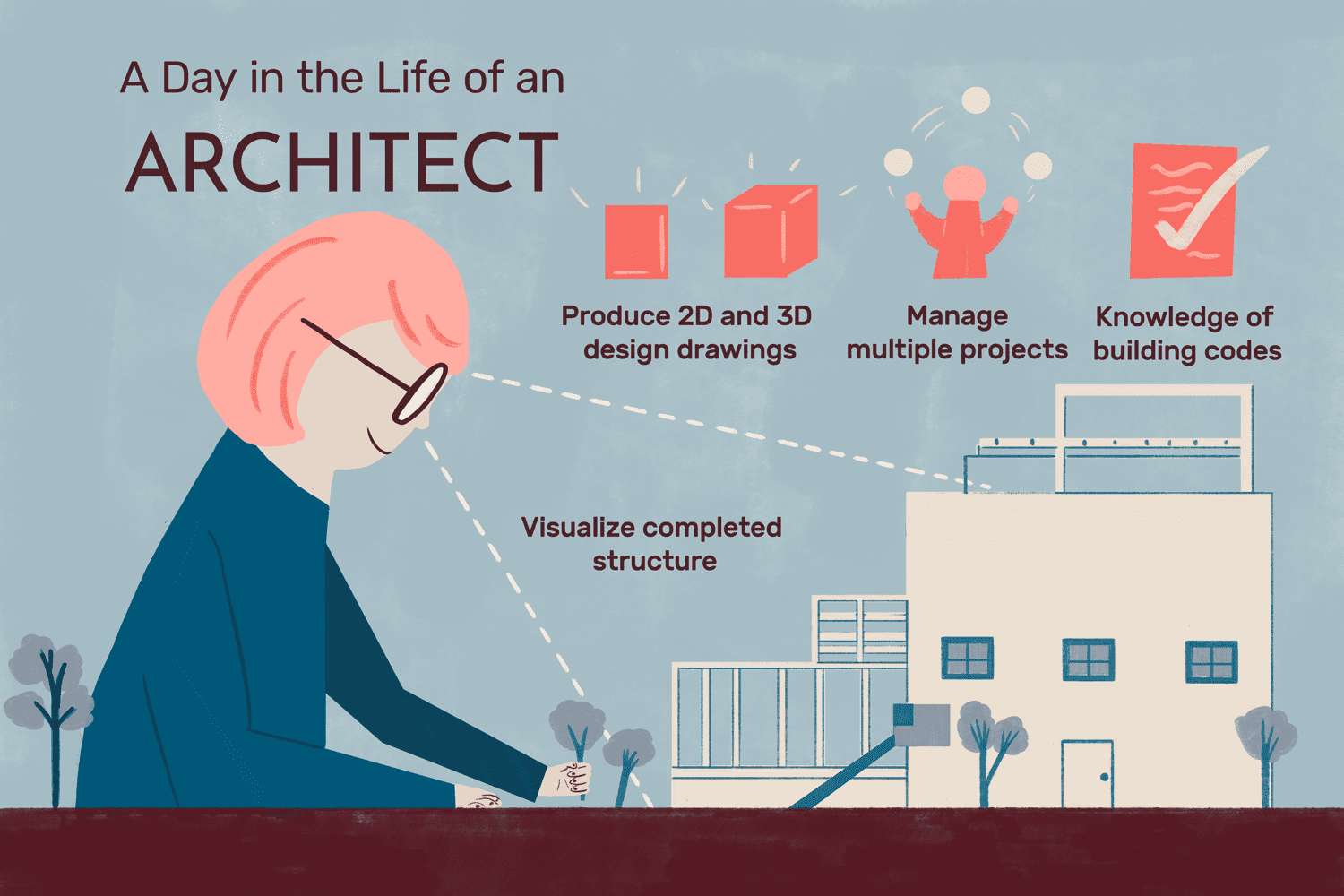Career Guide for Architectural Designer : Skills, Roles & Salaries 2025

Table of Contents
“Architecture is the thoughtful making of space.”- Famous Architect Louis Kahn
The role of architectural designers in the built environment extends beyond mere construction. They are pivotal in addressing broader societal issues such as urbanisation, climate change, and resource management. Through thoughtful planning and design, architects contribute to the development of resilient and adaptable communities. They advocate for sustainable practices, such as using eco-friendly materials and integrating renewable energy sources to minimise environmental footprints.
Understanding the Role of an Architectural Designer
An architectural design process shapes the way we live, work, and interact with the people and the environment around us. So, whether you want to work with an MNC or seek freelance architectural designers jobs, having a thorough understanding of the job profile is crucial. Now, let’s explore the scope of work and responsibilities that define the architectural designer profession and how can architects earn more.
1. What is the Scope of Work in Architectural Design Jobs?
-
Concept Development
Architectural designers translate ideas into tangible visions, considering the client’s needs, the site’s potential, and the project’s overall feasibility. This phase involves extensive research, brainstorming, and sketching to create initial design concepts that align with the client’s goals.
-
Design and Planning
This phase involves creating precise drawings and models that specify the dimensions, materials, and construction methods. Professionals in architectural designer jobs use advanced software tools like Revit, AutoCAD, and SketchUp to develop detailed architectural plans.
-
Code Compliance and Material Selection
Choosing the right material is crucial for a building’s aesthetic and functionality. Designers research and select appropriate materials that align with the project’s design and budget. Further, they must also adhere to local building codes, zoning laws, and safety regulations, ensuring that the design is compliant with all legal requirements.
-
Coordination and Collaboration
Architectural designers collaborate with a range of professionals, including engineers, contractors, and interior designers, to bring their designs to life. This ensures that all project aspects, from structural integrity to aesthetic coherence, are seamlessly integrated.
-
Client Interaction and Presentation
Working in architectural design jobs involves maintaining regular communication with clients, providing updates and seeking approvals and feedback. People must be adept at presenting their ideas clearly and convincingly, using visual aids like renderings, models, and virtual tours.
-
Construction Oversight
The role of an architectural designer extends into the construction phase, where they provide oversight and guidance to ensure that the project is executed according to the design plans. They conduct site visits, review progress, and address any design-related issues that emerge during construction.
Also Check out: How to Earn More as an Architect ? {Active & Passive Incomes}
Skills & Qualifications Needed for Architectural Designer Jobs
1. Educational Background
-
Bachelor’s Degree
A bachelor’s degree in architecture, architectural design, or a related field is typically the minimum requirement for an architectural designer. The degree covers fundamental topics such as architectural theory, building materials, structural engineering, and design principles.
-
Internships and Practical Experience
Hands-on experience through internships during or after formal education is vital. These experiences provide real-world exposure to design processes, project management, and collaboration within architectural firms. This makes a difference during salary negotiation for architects in top global MNCs.
2. Technical Skills
-
Proficiency in Design Software
For architectural designer jobs, professionals must be skilled in a variety of design software to create detailed plans and models. AutoCAD, Sketchup, Revit, Rhino, Grasshopper, ArchiCAD, Photoshop, and Lumion are examples of highly sought-after architectural design software.
-
Knowledge of Building Codes and Regulations
Understanding local building codes, zoning laws, and regulations is crucial. This knowledge ensures that designs are compliant with safety standards and legal requirements.
-
Structural Engineering Principles
A solid grasp of structural engineering principles helps designers create safe and stable structures. This includes understanding load-bearing elements, material properties, and construction techniques.

3. Soft Skills
-
Creativity and Innovation
Architectural designers need a strong creative flair to develop innovative and aesthetically pleasing designs. They must be able to think outside the box and bring fresh ideas to the table.
-
Communication Skills
Effective verbal and written communication skills are essential for presenting ideas to clients, collaborating with team members, and explaining design concepts clearly and convincingly.
-
Problem-Solving Abilities
Architectural designers often encounter challenges that require quick and effective solutions. Strong problem-solving skills help them navigate design issues and technical obstacles.
-
Team Collaboration
Building design is a collaborative effort. Therefore, designers must work well in team settings, coordinating with architects, engineers, contractors, and clients to achieve project goals.
4. Certification and Licensing
For architects to advance their careers and secure high-paying architecture jobs, it is essential that they continually upskill themselves by learning about the most innovative design concepts and technologies. For this purpose, they must consider enrolling in courses that teach BIM (Building Information Modelling), Computational Design, and parametric modelling.
Platforms such as Novatr provide certification programs for architects to upskill in new-age software and technologies, thereby enabling them to bag better work and earning opportunities.
Career Path & Progression for Architectural Designers
If you are wondering what are the job roles you can explore as an architect and what is the range of architectural designer salary, then here are the some ballpark figures that can help.
1. Entry-Level Roles
-
Intern Architect
Experience: 0 - 6 months
Salary: INR 1.8 - 3 lakhs per annum
Role: Intern architects are usually students or recent graduates who work under the supervision of licensed architects. Their tasks include preparing design documents, conducting site visits, and participating in project meetings.
-
Junior Architectural Designer
Experience: 0 - 1 year
Salary: INR 2.5 - 4 lakhs per annum
Architectural Designer Job Description: Junior architectural designer jobs entail assisting senior designers and architects with drafting, model making, and preliminary design work. They gain experience in design software and learn the fundamentals of building codes and regulations.
2. Mid-Level Roles
-
Architectural Designer
Experience: 3 - 5 year
Architectural Designer Salary: INR 4 - 8 lakhs per annum
Role: Architectural designers take on more responsibility, working on detailed design development, creating construction documents, and coordinating with consultants and contractors. They often handle smaller projects independently.
-
Project Architect
Experience: 5 - 8 year
Salary: INR 6 - 12 lakhs per annum
Role: Project architects oversee the design and execution of architectural projects. They manage project timelines, budgets, and resources, ensuring that designs meet client requirements and regulatory standards.
3. Senior-Level Roles
-
Senior Architectural Designer Jobs
Experience Needed: 8 - 12 years
Salary: INR 10 - 18 lakhs per annum
Role: Senior architectural designer job description involves leading the conceptual and schematic design phases of projects. They mentor junior staff, develop innovative design solutions, and ensure the aesthetic quality of the firm's work.
-
Lead Designer
Experience Needed: 10 - 15 years
Salary: INR 12 - 20 lakhs per annum
Role: Lead designers are responsible for the project’s overall design vision. They work closely with clients to understand their needs and translate them into cohesive design concepts. They also guide the design team throughout the project lifecycle.
Also Check out: What is Career Stagnation & How Can Architects Escape it
4. Advanced Roles
-
Principal Architect
Experience Needed: 15 - 20 years
Architectural Designer Salary: INR 20 - 35 lakhs per annum
Role: Principal architects are senior leaders within architectural firms. They focus on business development, client relations, and high-level project oversight. They ensure the firm's design philosophy is maintained across all projects.
-
Design Director
Experience Needed: 20+ years
Architectural Designer Salary: INR 25 - 40 lakhs per annum
Role: Design directors set the creative direction for the firm and oversee multiple projects simultaneously. They drive innovation, manage senior design staff, and play a crucial role in shaping the firm's strategic goals.
Top 5 Certification Courses for Architectural Designer Jobs
If you wish to excel in on-site or remote architectural design jobs then the best way to do so is through upskilling. These courses can significantly boost your architectural dsesigner salary. So, let’s have a look at the best program that professionals can participate in.
1. BIM Professional Course for Architects by Novatr
Duration: Seven months
Fee: INR 1,95,000
BIM Professional Course for Architects is one of the most well-rounded courses offering insights into BIM processes, workflows, and tools. Throughout the course, professionals get the opportunity to learn 15+ BIM software and their industry applications. Participants work on ISO-certified industry projects to implement their knowledge in real-time under the guidance of seasoned industry experts. Also, the platform offers placement assistance to its participants allowing them to explore better career avenues.
2. Professional Revit & BIM Certification Course by Kaarwan
Duration: Four months
Fee: INR 62,999
This extensive online course on Revit integrated with BIM prepares learners to tackle practical challenges in the industry. The course teaches basics of 3D modelling and progresses into the creation of parametric models. It also covers the topics of adaptive families, scheduling, quantification, and budgeting. Further, the program imparts knowledge about sustainable design and energy-efficient architecture, delivered through industry experts.
3. BIM Ready (Architecture Advanced) Course by TecnoStruct Academy
Duration: Eight months
Fee: INR 2,00,000
Curated for architectural designers, this course teaches 21+ BIM software and plugins that help professionals become experts. Divided into 14 modules, the course speaks about parametric modelling, generative design, and computational design covering the fundamentals and advanced concepts. The curriculum also covers 4D and 5D BIM, thus helping professionals unlock new levels of efficiency in building design and construction. The course is led by top practicing professionals and provides placement assistance to the participants.

4. Revit Architecture Course by SMECLabs
Duration: Not Defined
Fee: Not Defined
Fundamentally focussed on Revit, this course for architectural designers shares insights into the Revit environment and workflows. The course covers topics such as exploring user interface, working with Revit elements, creating railing and stairs, presenting the model of a building, and controlling object visibility. Through the course, learners can understand all about parametric modelling from basics to advanced settings as well as rendering - all of which are skills that help improve architectural designer salary.
Also Check out: Top 7 Innovative Architectural Mega Projects Around the World
5. BIM in AEC Industry Using Revit by Skill Lync
Duration: Four months
Fee: INR 40,000
This course for architectural designer jobs offered by Skill-Lync is designed to equip both working professionals and students with a foundational understanding of BIM. The course covers essential topics, starting with basic modeling and template creation, and advancing to more complex tasks such as developing parametric models and adaptive families. Participants will also learn about scheduling, quantification, estimation, energy calculations, and sustainable design analysis, preparing them to handle real-world challenges in the industry effectively.
In Conclusion
As architectural design evolves, the future of design will prioritise inclusivity, accessibility, and the well-being of individuals. This will foster a holistic and human-centric approach to creating spaces. To achieve this, it is vital for professionals to acquaint themselves with new tools and technologies to enhance their creativity and technical accuracy.
If you want to bag rewarding architectural career opportunities, upskilling in BIM would be a smart move. We suggest you check out the BIM Professional Course for Architects by Novatr to learn BIM software, processes, and workflows. Participants get the opportunity to learn from industry experts and build on their experiences. Additionally, individuals can work on capstone projects and apply their learnings to real-world projects. Novatr also provides placement assistance to participants, comprehensively aiding them to level up their career. Explore the course today!
Learn more about architectural designing by visiting our Resources Page.

 Thanks for connecting!
Thanks for connecting!


.png)
.jpg)





